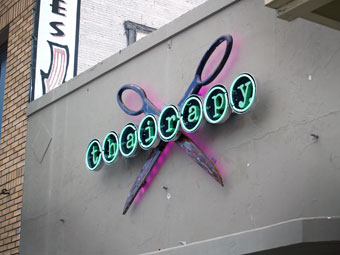San Marcos, Texas is a college town located about twenty-five miles from the seemingly boundless creative city limits of Austin, Texas. Yet even with its own vibrant, youthful atmosphere, the city’s sign code was being perceived by sign makers as very limited.
However one area sign shop managed to not only work with the city council to loosen up the code and show them the value of artistic-driven signage, but they also inspired the plan for a new matching funds program for updating business signage in the San Marcos downtown district.
Local shop Blackout Signs & Metalworks takes pride not only in imagining and creating one-of-kind signs and sculptures but also in knowing how the signage works with the visual landscape and complements the buildings onto which they’re attached.
Frustrated by what they viewed as a restrictive sign code, the shop met with members of the San Marcos Planning and Development Services Department (headed by Director Matthew Lewis) to work toward updating the ordinance to allow for more creative signage.
The result: Blackout Signs ended up being invited by the city to help brainstorm ideas and review case studies.
“We understood the sign code was meant to be fair to everybody and prevent things from getting out of hand,” says Blackout Signs Owner Jay Gordon, “but it was horribly [limited] if you were trying to do something creative.
“It didn’t address 3-D elements, different lighting sources, or designing signs to complement the architecture or environment.”
Blackout Signs reviewed documents to see what was (and was not) allowed and what type of signage had been grandfathered into the ordinance.
“And since we’d worked closely with the City Council, we were able to see them pass some revisions,” says Gordon, noting he even invited city officials out to his shop to check out the creative work they were building and meet the sign makers “behind the curtain.”
Although Gordon admits that he and his shop occasionally encountered “creative differences” with city officials during the early stages, he does credit them for being open-minded.
“They liked the work that we were doing and wanted to figure out a way to allow more [artistic] types of signs,” he says.
Gordon provided input about the benefits of artistic-driven signage and sculptures and credits the City Council for being open to suggestions. “I don’t think they knew what was possible with signage and how effective a well designed and crafted sign could be,” he says.
For example, Gordon really loves building projecting, hanging signs. “The maximum square footage allowed for them used to be six square feet,” he says, “but after working with city officials, they changed it now to nine square feet.
“For odd-shaped signs (circles, ovals, shields, etc.), the old way of calculating the sign area was to draw a square box around it. Now they measure the actual area of the sign. So we can work with something with a negative space around it, like a horseshoe or a donut.”
Gordon is also pleased the city now allows for a minimum height for signs to project above a building. “This adds a bit more dynamic nature to some signs,” he says.
And thanks to the city-and-sign shop working relationship here, a beneficial matching funds program to renovate the signage in the downtown area is being created.
San Marcos officials are in the midst of transforming the downtown district into a more pedestrian- and bicycle-friendly environment. While fixing streets and roads there, they also noticed that the surrounding signage and awnings needed some serious updating.
The downtown area covers thirty-seven-square blocks, yet a lot of signage being used by businesses in the area was non-conforming. Many were panels built out of plywood, without any consideration of it being part of the city’s makeup.
Distressed city officials decided it was time to update the sign code to add a greater level of quality to the signs and push sign makers and business owners to be a little more creative.
“The signs there were designed for high speeds,” says Matthew Lewis, “and signage increases in size as the speed goes up.

“But now that we have twenty-five-miles-per-hour speed limits, the signage can be custom-tailored for pedestrians and slow-moving traffic. This allowed us to open up the quality and type of signs.”
The Planning and Development Services department first sent a group of interns to the area to make a checklist of the most out-of-compliant signage and created an inventory list of the ones they felt needed tackling quickly.
After doing an analysis of the downtown area, the San Marcos Planning & Development services wrote a new development code to create organic, natural development patterns that would fit within the new sign ordinance. “We see signage as part of the architecture,” says Lewis, “and it needs to be done appropriately.”
“[Lewis] and the Planning and Development Services department recognized how signs helped small businesses stand out and how they even improve the aesthetic look when they jive with their building,” says an impressed Gordon.
Since the city already had downtown improvement funds in the budget, they’re considering a sign and façade improvement program for faster compliance.
“These funds would allow downtown business owners to basically bring their sign into compliance,” says Lewis, “and we’ll do matching grant funds to get their signage brought up to the new standards.”
According to Lewis, the city has been flexible as to what’s allowed—venturing more toward traditional downtown signage with a modern flair: a-frame signs, projection signs, hanging signs, wall signs, murals, and even neon. While working with some business owners in the area, Gordon has even uncovered and restored some old ghost signs that had been painted onto walls. (Note: Plastic-faced signs still aren’t allowed.)
In addition to Blackout Signs, other sign shops in the area are helping out with this matching funds program. Each has their own approach, but when he meets with a client for this program, Gordon reduces the design time rates for them. “It’s a show of solidarity for what the city is trying to do,” he says. “Once customers come up with half the money for the sign, we get the budget squared away and design within that range.
“Once that’s done, it’s just some simple paperwork to submit to the city. If it all meets the code, then we’re off to the races!”
Working more closely with sign makers has allowed San Marcos officials to see that the type of signage is more important than the number. In fact, the new ordinance even allows for more signage. “It’s more that signage is now compatible with our downtown streets,” says Lewis.
The matching funds program is slated to continue until it runs out of money. (There were an x-amount of funds budgeted at the project’s start.) “I think it’s amazing,” says Gordon. “It’s a huge commitment from the city to help their small businesses succeed.
“It also keeps the money in the local economy, which is real cool.”
For Gordon, his experiences working with the city has awakened his civic pride. “I’ve always loved my town, but getting to meet and work with all these different people from different departments has stoked us even more,” he says. “And if you’re passionate about something and believe in it, you really can change things.”
Gordon feels there’s a real good “pulse” in San Marcos thanks to the “younger blood” getting into key city positions and considering signage more as art. “They’re putting time and energy into making it a cool experience for people getting around,” he says.”
And for San Marcos and its sign makers, they can take pride that, thanks to these cooperative code revisions, the city is now generating its own fair share of sign cool.
By Jeff Wooten
All photos: Blackout Signs & Metalworks.











